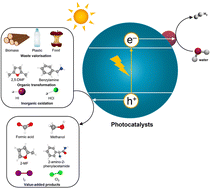Alternatives to water oxidation in the photocatalytic water splitting reaction for solar hydrogen production
Abstract
The photocatalytic water splitting process to produce H2 is an attractive approach to meet energy demands while achieving carbon emission reduction targets. However, none of the current photocatalytic devices meets the criteria for practical sustainable H2 production due to their insufficient efficiency and the resulting high H2 cost. Economic viability may be achieved by simultaneously producing more valuable products than O2 or integrating with reforming processes of real waste streams, such as plastic and food waste. Research over the past decade has begun to investigate the possibility of replacing water oxidation with more kinetically and thermodynamically facile oxidation reactions. We summarize how various alternative photo-oxidation reactions can be combined with proton reduction in photocatalysis to achieve chemical valorization with concurrent H2 production. By examining the current advantages and challenges of these oxidation reactions, we intend to demonstrate that these technologies would contribute to providing H2 energy, while also producing high-value chemicals for a sustainable chemical industry and eliminating waste.

- This article is part of the themed collections: Recent Review Articles and Nanoscale 2023 Emerging Investigators


 Please wait while we load your content...
Please wait while we load your content...